A Review of Smart Cities Based on the Internet of Things Concept
Abstract
:1. Introduction
1.1. Concepts
1.2. Motivations
2. IoT Technologies for Smart Cities
- Home Area Networks (HAN) which use short-range standards like, ZigBee, Dash7, and Wi-Fi. All monitoring and control components in a home are connected by the HAN.
- Wide Area Networks (WAN), provide communication between customers and distribution utilities which require much broader coverage than HAN and for implementation needs fiber cable or broadband wireless like 3G and LTE.
- Field Area Networks, which are used for connection between customers and substations [5].
2.1. Radio-Frequency Identification (RFID)
2.2. Near Field Communication (NFC)
2.3. Low Rate Wireless Personal Area Network (LWPAN)
2.3.1. ZigBee
2.3.2. 6LoWPAN
2.4. Wireless Sensor Networks (WSNs)
2.5. Dash7
2.6. 3G and Long Term Evolution (LTE)
2.7. Addressing
2.8. Middleware
2.9. Smart Cities Platforms and Standards
3. Actual IoT Applications for Smart Cities
3.1. Smart Homes
3.2. Smart Parking Lots
3.3. Healthcare
3.4. Water and Weather Systems
3.5. Transportation & Vehicular Traffic
3.6. Environmental Pollution
3.7. Surveillance Systems
4. IoT Potential Applications for Smart Cities
4.1. Smart Cities and Communities
4.2. Smart Homes and Buildings
4.3. Responsive Customers
4.4. Smart Energy and Smart Grids
5. Practical Experience around the World
5.1. Amsterdam, The Netherlands
5.2. Chicago and New York, USA
5.3. Busan, South Korea
5.4. Nice, France
5.5. Padova, Italy
5.6. Business Models and Scaling-Up Practical Smart Grids
- 1-
- Temper: The value is creating business opportunities, the business model is open network and the pattern is open.
- 2-
- Geneva: The value is developing high-speed networks and smart grids for energy management, the business model is open access and the pattern is open.
- 3-
- Seoul: The value is creating a city as a product, the business model is a full-service provider, and the pattern is unbundling.
- 4-
- London: The value is managing climate change, the business model is the full-service provider, and the pattern is unbundling [71].
6. Challenges
6.1. Security and Privacy
6.2. Heterogeneity
6.3. Reliability
6.4. Large Scale
6.5. Legal and Social Aspects
6.6. Big Data
6.7. Sensor Networks
6.8. DR Barriers
7. Conclusions, Remarks and Future Trends
Acknowledgments
Author Contributions
Conflicts of Interest
References
- Rathore, M.M.; Ahmad, A.; Paul, A.; Rho, S. Urban planning and building smart cities based on the Internet of Things using Big Data analytics. Comput. Netw. 2016, 101, 63–80. [Google Scholar] [CrossRef]
- Zhu, C.; Leung, V.C.M.; Shu, L.; Ngai, E.C.H. Green Internet of Things for Smart World. IEEE Access 2015, 3, 2151–2162. [Google Scholar] [CrossRef]
- Botta, A.; de Donato, W.; Persico, V.; Pescapé, A. Integration of Cloud computing and Internet of Things: A survey. Future Gener. Comput. Syst. 2016, 56, 684–700. [Google Scholar] [CrossRef]
- Jaradat, M.; Jarrah, M.; Bousselham, A.; Jararweh, Y.; Al-Ayyoub, M. The Internet of Energy: Smart Sensor Networks and Big Data Management for Smart Grid. Procedia Comput. Sci. 2015, 56, 592–597. [Google Scholar] [CrossRef]
- Hancke, G.; Silva, B.; Hancke, G., Jr. The Role of Advanced Sensing in Smart Cities. Sensors 2012, 13, 393–425. [Google Scholar] [CrossRef] [PubMed]
- Kyriazis, D.; Varvarigou, T.; White, D.; Rossi, A.; Cooper, J. Sustainable smart city IoT applications: Heat and electricity management amp; Eco-conscious cruise control for public transportation. In Proceedings of the 2013 IEEE 14th International Symposium on “A World of Wireless, Mobile and Multimedia Networks” (WoWMoM), Madrid, Spain, 4–7 June 2013; pp. 1–5. [Google Scholar]
- Strategic Opportunity Analysis of the Global Smart City Market. Available online: http://www.egr.msu.edu/~aesc310-web/resources/SmartCities/Smart%20City%20Market%20Report%202.pdf (accessed on 24 February 2017).
- Gubbi, J.; Buyya, R.; Marusic, S.; Palaniswami, M. Internet of Things (IoT): A vision, architectural elements, and future directions. Future Gener. Comput. Syst. 2013, 29, 1645–1660. [Google Scholar] [CrossRef]
- Atzori, L.; Iera, A.; Morabito, G. The Internet of Things: A survey. Comput. Netw. 2010, 54, 2787–2805. [Google Scholar] [CrossRef]
- Internet of Things in 2020: Roadmap for the Future. Available online: http://www.smart-systems-integration.org/public/documents/publications/Internet-of-Things_in_2020_EC-EPoSS_Workshop_Report_2008_v3.pdf (accessed on 24 February 2017).
- Six Technologies with Potential Impacts on US Interests Out to 2025. Available online: https://fas.org/irp/nic/disruptive.pdf (accessed on 24 February 2017).
- Alamri, A.; Ansari, W.S.; Hassan, M.M.; Hossain, M.S.; Alelaiwi, A.; Hossain, M.A. A Survey on Sensor-Cloud: Architecture, Applications, and Approaches. Int. J. Distrib. Sens. Netw. 2013, 9, 917923. [Google Scholar] [CrossRef]
- Kosmatos, E.A.; Tselikas, N.D.; Boucouvalas, A.C. Integrating RFIDs and Smart Objects into a UnifiedInternet of Things Architecture. Adv. Internet Things 2011, 1, 5. [Google Scholar] [CrossRef]
- Rawat, P.; Singh, K.D.; Chaouchi, H.; Bonnin, J.M. Wireless sensor networks: A survey on recent developments and potential synergies. J. Supercomput. 2014, 68, 1–48. [Google Scholar] [CrossRef]
- Zanella, A.; Bui, N.; Castellani, A.; Vangelista, L.; Zorzi, M. Internet of Things for Smart Cities. IEEE Internet Things J. 2014, 1, 22–32. [Google Scholar]
- Medagliani, P.; Leguay, J.; Duda, A.; Rousseau, F.; Duquennoy, S.; Raza, S.; Ferrari, G.; Gonizzi, P.; Cirani, S.; Veltri, L.; et al. Internet of Things Applications—From Research and Innovation to Market Deployment. In Bringing IP to Low-Power Smart Objects: The Smart Parking Case in the CALIPSO Project; The River Publisher Series in Communication: Delft, The Netherlands, 2014; pp. 287–313. [Google Scholar]
- Elmangoush, A.; Alhazmi, A.; Magedanz, T.; Schuch, W.; Estevez, C.; Ehijo, A.; Wu, J.; Nguyen, T.; Ventura, N.; Mwangama, J.; et al. Towards Unified Smart City Communication Platforms. In Proceedings of the Workshop on Research in Information Systems and Technologies, Chillán, Chile, 16 October 2015. [Google Scholar]
- IEEE-SA—IEEE Get 802 Program—802.15: Wireless PANs. Available online: https://standards.ieee.org/about/get/802/802.15.html (accessed on 24 February 2017).
- Shafie-Khah, M.; Heydarian-Forushani, E.; Osório, G.J.; Gil, F.A.S.; Aghaei, J.; Barani, M.; Catalão, J.P.S. Optimal Behavior of Electric Vehicle Parking Lots as Demand Response Aggregation Agents. IEEE Trans. Smart Grid 2016, 7, 2654–2665. [Google Scholar] [CrossRef]
- Li, X.; Lu, R.; Liang, X.; Shen, X.; Chen, J.; Lin, X. Smart community: An internet of things application. IEEE Commun. Mag. 2011, 49, 68–75. [Google Scholar] [CrossRef]
- Stratigea, A. The concept of “smart cities”. Towards community development? Netcom. Réseaux Commun. Territ. 2012, 26-3/4, 375–388. [Google Scholar] [CrossRef]
- Neyestani, N.; Damavandi, M.Y.; Shafie-khah, M.; Catalão, J.P.S. Modeling the PEV traffic pattern in an urban environment with parking lots and charging stations. In Proceedings of the 2015 IEEE Eindhoven PowerTech, Eindhoven, The Netherlands, 29 June–2 July 2015; pp. 1–6. [Google Scholar]
- Yazdani-Damavandi, M.; Moghaddam, M.P.; Haghifam, M.R.; Shafie-khah, M.; Catalão, J.P.S. Modeling Operational Behavior of Plug-in Electric Vehicles’ Parking Lot in Multienergy Systems. IEEE Trans. Smart Grid 2016, 7, 124–135. [Google Scholar] [CrossRef]
- Neyestani, N.; Damavandi, M.Y.; Shafie-Khah, M.; Contreras, J.; Catalão, J.P.S. Allocation of Plug-In Vehicles’ Parking Lots in Distribution Systems Considering Network-Constrained Objectives. IEEE Trans. Power Syst. 2015, 30, 2643–2656. [Google Scholar] [CrossRef]
- Lee, S.; Yoon, D.; Ghosh, A. Intelligent parking lot application using wireless sensor networks. In Proceedings of the 2008 International Symposium on Collaborative Technologies and Systems, Irvine, CA, USA, 19–23 May 2008; pp. 48–57. [Google Scholar]
- Niyato, D.; Hossain, E.; Camorlinga, S. Remote patient monitoring service using heterogeneous wireless access networks: Architecture and optimization. IEEE J. Sel. Areas Commun. 2009, 27, 412–423. [Google Scholar] [CrossRef]
- The Urban Internet of Things. Available online: http://datasmart.ash.harvard.edu/news/article/the-urban-internet-of-things-727 (accessed on 24 February 2017).
- Shafie-Khah, M.; Heydarian-Forushani, E.; Golshan, M.E.H.; Siano, P.; Moghaddam, M.P.; Sheikh-El-Eslami, M.K.; Catalão, J.P.S. Optimal trading of plug-in electric vehicle aggregation agents in a market environment for sustainability. Appl. Energy 2016, 162, 601–612. [Google Scholar] [CrossRef]
- Li, X.; Shu, W.; Li, M.; Huang, H.Y.; Luo, P.E.; Wu, M.Y. Performance Evaluation of Vehicle-Based Mobile Sensor Networks for Traffic Monitoring. IEEE Trans. Veh. Technol. 2009, 58, 1647–1653. [Google Scholar]
- Maisonneuve, N.; Stevens, M.; Niessen, M.E.; Hanappe, P.; Steels, L. Citizen Noise Pollution Monitoring. In Proceedings of the 10th Annual International Conference on Digital Government Research: Social Networks: Making Connections between Citizens, Data and Government, Puebla, Mexico, 17–21 May 2009; pp. 96–103. [Google Scholar]
- Wang, J.; Chen, D.; Chen, H.; Yang, J. On pedestrian detection and tracking in infrared videos. Pattern Recognit. Lett. 2012, 33, 775–785. [Google Scholar] [CrossRef]
- Damen, D.; Hogg, D. Detecting Carried Objects from Sequences of Walking Pedestrians. IEEE Trans. Pattern Anal. Mach. Intell. 2012, 34, 1056–1067. [Google Scholar] [CrossRef] [PubMed]
- Calavia, L.; Baladrón, C.; Aguiar, J.M.; Carro, B.; Sánchez-Esguevillas, A. A semantic autonomous video surveillance system for dense camera networks in Smart Cities. Sensors 2012, 12, 10407–10429. [Google Scholar] [CrossRef] [PubMed]
- Leadership in Enabling and Industrial Technologies—Horizon 2020—European Commission. Available online: http://programmes/horizon2020/en/h2020-section/leadership-enabling-and-industrial-technologies (accessed on 24 February 2017).
- Ballon, P.; Glidden, J.; Kranas, P.; Menychtas, A.; Ruston, S.; van der Graaf, S. Is there a need for a Cloud platform for European smart cities? In Proceedings of the eChallenges 2011 Conference and Exhibition, Florence, Italy, 26–28 October 2011; International Information Management Corporation: Dublin, Ireland, 2011. [Google Scholar]
- Suciu, G.; Vulpe, A.; Halunga, S.; Fratu, O.; Todoran, G.; Suciu, V. Smart Cities Built on Resilient Cloud Computing and Secure Internet of Things. In Proceedings of the 2013 19th International Conference on Control Systems and Computer Science, Bucharest, Romania, 29–31 May 2013; pp. 513–518. [Google Scholar]
- ClouT | ClouT: Cloud of Things for Empowering the Citizen Clout in Smart Cities. Available online: http://clout-project.eu/ (accessed on 24 February 2017).
- Petrolo, R.; Mitton, N.; Soldatos, J.; Hauswirth, M.; Schiele, G. Integrating wireless sensor networks within a city cloud. In Proceedings of the 2014 Eleventh Annual IEEE International Conference on Sensing, Communication, and Networking Workshops (SECON Workshops), Singapore, 30 June–3 July 2014; pp. 24–27. [Google Scholar]
- Chen, S.Y.; Lai, C.F.; Huang, Y.M.; Jeng, Y.L. Intelligent home-appliance recognition over IoT cloud network. In Proceedings of the 2013 9th International Wireless Communications and Mobile Computing Conference (IWCMC), Sardinia, Italy, 1–5 July 2013; pp. 639–643. [Google Scholar]
- Han, D.M.; Lim, J.H. Smart home energy management system using IEEE 802.15.4 and zigbee. IEEE Trans. Consum. Electron. 2010, 56, 1403–1410. [Google Scholar] [CrossRef]
- Ye, X.; Huang, J. A framework for Cloud-based Smart Home. In Proceedings of the 2011 International Conference on Computer Science and Network Technology, Harbin, China, 24–26 December 2011; Volume 2, pp. 894–897. [Google Scholar]
- Martirano, L. A smart lighting control to save energy. In Proceedings of the 6th IEEE International Conference on Intelligent Data Acquisition and Advanced Computing Systems, Prague, Czech Republic, 15–17 September 2011; Volume 1, pp. 132–138. [Google Scholar]
- Castro, M.; Jara, A.J.; Skarmeta, A.F.G. Smart Lighting Solutions for Smart Cities. In Proceedings of the 2013 27th International Conference on Advanced Information Networking and Applications Workshops, Barcelona, Spain, 25–28 March 2013; pp. 1374–1379. [Google Scholar]
- Siano, P.; Sarno, D. Assessing the benefits of residential demand response in a real time distribution energy market. Appl. Energy 2016, 161, 533–551. [Google Scholar] [CrossRef]
- Siano, P. Demand response and smart grids—A survey. Renew. Sustain. Energy Rev. 2014, 30, 461–478. [Google Scholar] [CrossRef]
- Graditi, G.; Ippolito, M.G.; Lamedica, R.; Piccolo, A.; Ruvio, A.; Santini, E.; Siano, P.; Zizzo, G. Innovative control logics for a rational utilization of electric loads and air-conditioning systems in a residential building. Energy Build. 2015, 102, 1–17. [Google Scholar]
- Siano, P.; Graditi, G.; Atrigna, M.; Piccolo, A. Designing and testing decision support and energy management systems for smart homes. J. Ambient Intell. Human. Comput. 2013, 4, 651–661. [Google Scholar] [CrossRef]
- Strategic Plan for the IEA Demand-Side Management Programme 2008–2012. Available online: http://www.ieadsm.org/wp/files/Exco%20File%20Library/Participation/Final%20strategy%202008-2012.pdf (accessed on 24 February 2017).
- Arasteh, H.R.; Parsa Moghaddam, M.; Sheikh-El-Eslami, M.K.; Abdollahi, A. Integrating commercial demand response resources with unit commitment. Int. J. Electr. Power Energy Syst. 2013, 51, 153–161. [Google Scholar] [CrossRef]
- Balijepalli, V.S.K.M.; Pradhan, V.; Khaparde, S.A.; Shereef, R.M. Review of demand response under smart grid paradigm. In Proceedings of the ISGT2011-India, Kerala, India, 1–3 December 2011; pp. 236–243. [Google Scholar]
- Koutsopoulos, I.; Tassiulas, L. Control and Optimization Meet the Smart Power Grid—Scheduling of Power Demands for Optimal Energy Management. In Proceedings of the 2nd International Conference on Energy-Efficient Computing and Networking, New York, NY, USA, 31 May–1 June 2011. [Google Scholar]
- Parvania, M.; Fotuhi-Firuzabad, M. Demand Response Scheduling by Stochastic SCUC. IEEE Trans. Smart Grid 2010, 1, 89–98. [Google Scholar] [CrossRef]
- Electricity Technology Roadmap: Meeting the Critical Challenges of the 21st Century—Roadmap2003. Available online: http://mydocs.epri.com/docs/CorporateDocuments/StrategicVision/Roadmap2003.pdf (accessed on 24 February 2017).
- Arritt, R.F.; Dugan, R.C. Distribution System Analysis and the Future Smart Grid. IEEE Trans. Ind. Appl. 2011, 47, 2343–2350. [Google Scholar] [CrossRef]
- Jaradat, M.; Jarrah, M.; Jararweh, Y.; Al-Ayyoub, M.; Bousselham, A. Integration of renewable energy in demand-side management for home appliances. In Proceedings of the 2014 International Renewable and Sustainable Energy Conference (IRSEC), Ouarzazate, Morocco, 17–19 October 2014; pp. 571–576. [Google Scholar]
- Zhu, Z.; Tang, J.; Lambotharan, S.; Chin, W.H.; Fan, Z. An integer linear programming based optimization for home demand-side management in smart grid. In Proceedings of the 2012 IEEE PES Innovative Smart Grid Technologies (ISGT), Washington, DC, USA, 16–20 January 2012; pp. 1–5. [Google Scholar]
- Nguyen, H.K.; Song, J.B.; Han, Z. Demand side management to reduce Peak-to-Average Ratio using game theory in smart grid. In Proceedings of the 2012 Proceedings IEEE INFOCOM Workshops, Orlando, FL, USA, 25–30 March 2012; pp. 91–96. [Google Scholar]
- Saber, A.Y.; Venayagamoorthy, G.K. Plug-in Vehicles and Renewable Energy Sources for Cost and Emission Reductions. IEEE Trans. Ind. Electron. 2011, 58, 1229–1238. [Google Scholar]
- Zhabelova, G.; Vyatkin, V. Multiagent Smart Grid Automation Architecture Based on IEC 61850/61499 Intelligent Logical Nodes. IEEE Trans. Ind. Electron. 2012, 59, 2351–2362. [Google Scholar] [CrossRef]
- Miao, Y.; Bu, Y. Research on the architecture and key technology of Internet of Things (IoT) applied on smart grid. In Proceedings of the 2010 International Conference on Advances in Energy Engineering (ICAEE), Beijing, China, 19–20 June 2010; pp. 69–72. [Google Scholar]
- Amsterdam Smart City. Available online: https://amsterdamsmartcity.com/ (accessed on 24 February 2017).
- Smart City | Servei de Premsa | El Web de la Ciutat de Barcelona. Available online: http://ajuntament.barcelona.cat/premsa/tag/smart-city/ (accessed on 24 February 2017).
- Laursen, L. City Saves Money, Attracts Businesses with Smart City Strategy. Available online: https://www.technologyreview.com/s/532511/barcelonas-smart-city-ecosystem/ (accessed on 24 February 2017).
- TMBAPP (Metro Bus Barcelona) | Apps | iTunes | apps4BCN | All the Apps You Need for Barcelona! Available online: http://apps4bcn.cat/en/app/tmbapp-metro-bus-barcelona/111 (accessed on 24 February 2017).
- Transport & Traffic | IOS | The Best App Selection for Barcelona | Apps4bcn | All the Apps You Need for Barcelona! Available online: http://apps4bcn.cat/en/apps/index/Category:transport-i-tr-nsit (accessed on 24 February 2017).
- UrbanStep Barcelona | Apps | iTunes | apps4BCN | All the Apps You Need for Barcelona! Available online: http://apps4bcn.cat/en/app/urbanstep-barcelona/110 (accessed on 24 February 2017).
- ICT Regulation Toolkit. Available online: http://www.ictregulationtoolkit.org/practice_note?practice_note_id=3244 (accessed on 24 February 2017).
- Writer, S.B.-S. Staff Modest Gains in First Six Months of Santa Cruz’s Predictive Police Program. Available online: http://www.santacruzsentinel.com/article/zz/20120226/NEWS/120227300 (accessed on 24 February 2017).
- The Internet of Everything for Cities. Available online: http://pie.pascalobservatory.org/sites/default/files/ioe-smart-city_pov.pdf (accessed on 24 February 2017).
- Strickland, E. Cisco bets on South Korean smart city. IEEE Spectr. 2011, 48, 11–12. [Google Scholar] [CrossRef]
- Anthopoulos, L.G.; Fitsilis, P. Understanding Smart City Business Models: A Comparison; ACM Press: New York, NY, USA, 2015; pp. 529–534. [Google Scholar]
- Smart City Pilot Projects, Scaling Up or Fading Out? Experiences from Amsterdam. Available online: http://www.hva.nl/urban-management/over-um/nieuws/content/nieuwsberichten/2016/3/willem-van-winden-discussion.html (accessed on 24 February 2017).
- Christidis, K.; Devetsikiotis, M. Blockchains and Smart Contracts for the Internet of Things. IEEE Access 2016, 4, 2292–2303. [Google Scholar] [CrossRef]
- He, W.; Yan, G.; Xu, L.D. Developing Vehicular Data Cloud Services in the IoT Environment. IEEE Trans. Ind. Inform. 2014, 10, 1587–1595. [Google Scholar] [CrossRef]
- Petrolo, R.; Loscrì, V.; Mitton, N. Towards a smart city based on cloud of things, a survey on the smart city vision and paradigms. Trans. Emerg. Telecommun. Technol. 2017, 28, e2931. [Google Scholar] [CrossRef]
- Lazarescu, M.T. Design of a WSN Platform for Long-Term Environmental Monitoring for IoT Applications. IEEE J. Emerg. Sel. Top. Circuits Syst. 2013, 3, 45–54. [Google Scholar] [CrossRef]
- Mitton, N.; Papavassiliou, S.; Puliafito, A.; Trivedi, K.S. Combining Cloud and sensors in a smart city environment. EURASIP J. Wirel. Commun. Netw. 2012, 2012, 247. [Google Scholar] [CrossRef]
- Atkins, C.; Koyanagi, K.; Tsuchiya, T.; Miyosawa, T.; Hirose, H.; Sawano, H. A Cloud Service for End-User Participation Concerning the Internet of Things. In Proceedings of the 2013 International Conference on Signal-Image Technology Internet-Based Systems, Kyoto, Japan, 2–5 December 2013; pp. 273–278. [Google Scholar]
- Corsar, D.; Edwards, P.; Velaga, N.; Nelson, J.; Pan, J. Short Paper: Addressing the Challenges of Semantic Citizen-sensing. In Proceedings of the 4th International Conference on Semantic Sensor Networks, SSN’11, Aachen, Germany, 23 October 2011; Volume 839, pp. 101–106. [Google Scholar]
- Zaslavsky, A.; Perera, C.; Georgakopoulos, D. Sensing as a Service and Big Data. In Proceedings of the International Conference on Advances in Cloud Computing (ACC), Bangalore, India, July 2012. [Google Scholar]
- Akyildiz, I.F.; Melodia, T.; Chowdury, K.R. Wireless multimedia sensor networks: A survey. IEEE Wirel. Commun. 2007, 14, 32–39. [Google Scholar] [CrossRef]
- Zhao, F. Sensors meet the Cloud: Planetary-scale distributed sensing and decision making. In Proceedings of the 2010 9th IEEE International Conference on Cognitive Informatics (ICCI), Beijing, China, 7–9 July 2010; pp. 998–998. [Google Scholar]
- Kim, J.-H.; Shcherbakova, A. Common failures of demand response. Energy 2011, 36, 873–880. [Google Scholar] [CrossRef]

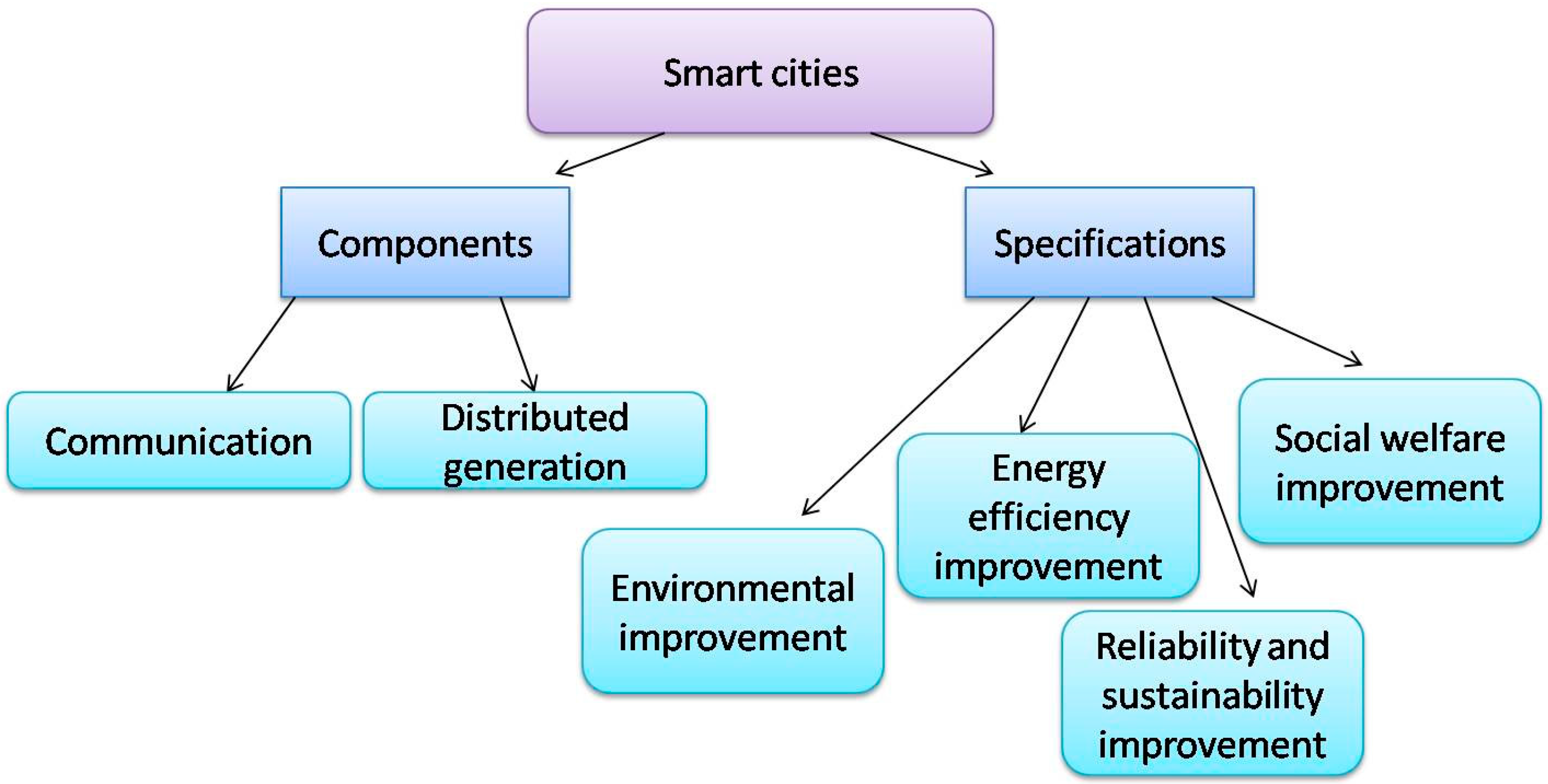
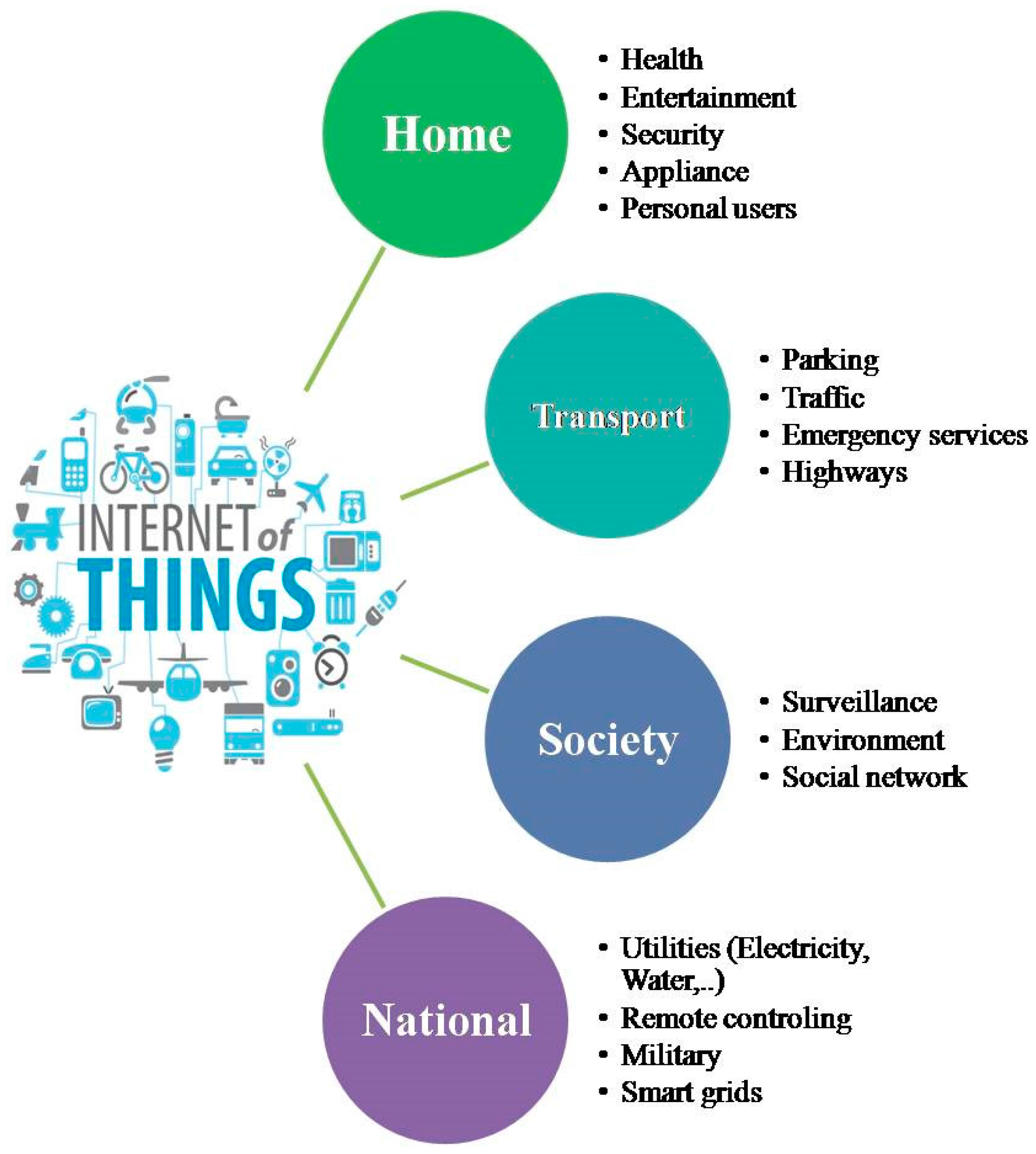
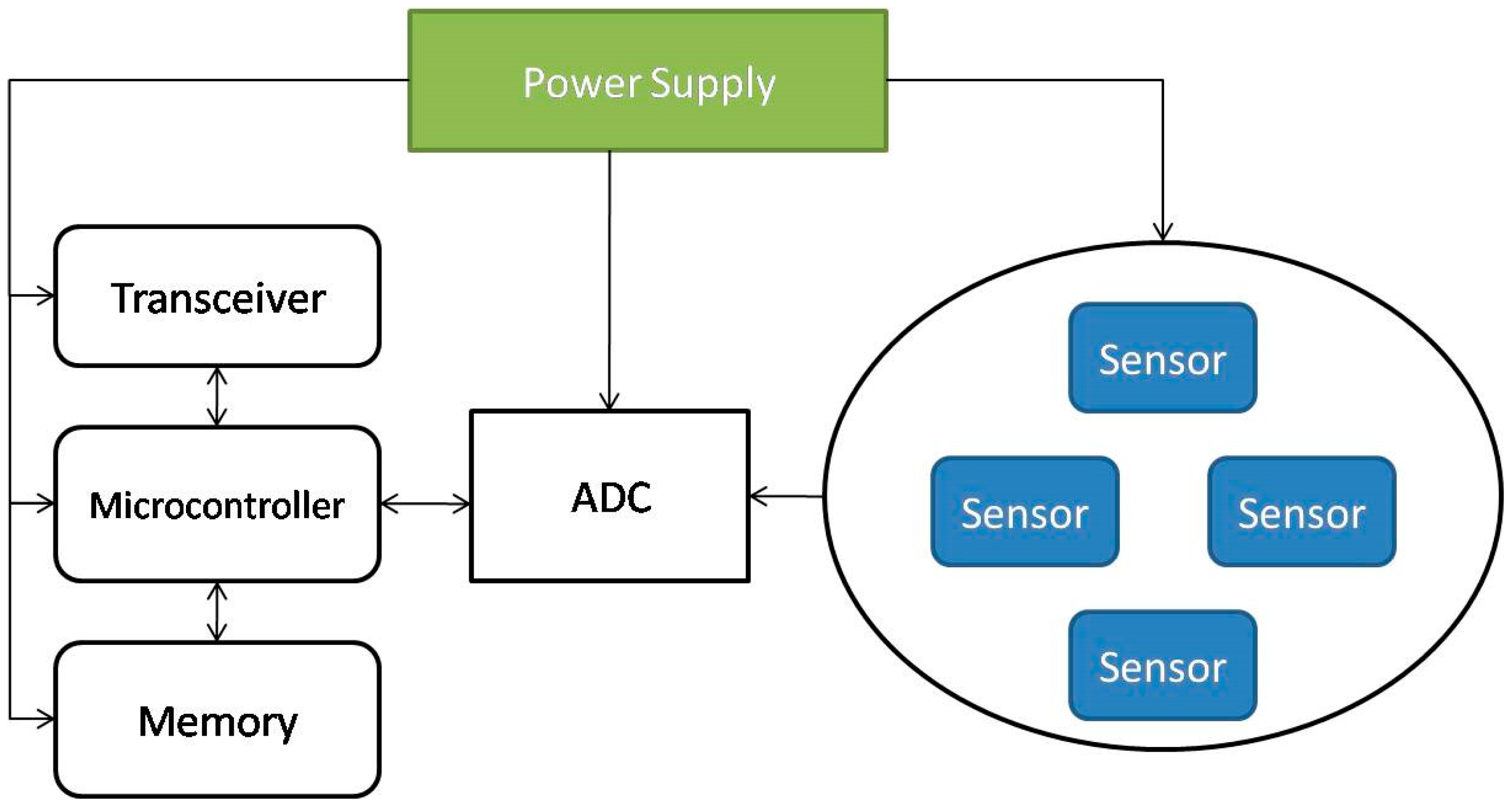
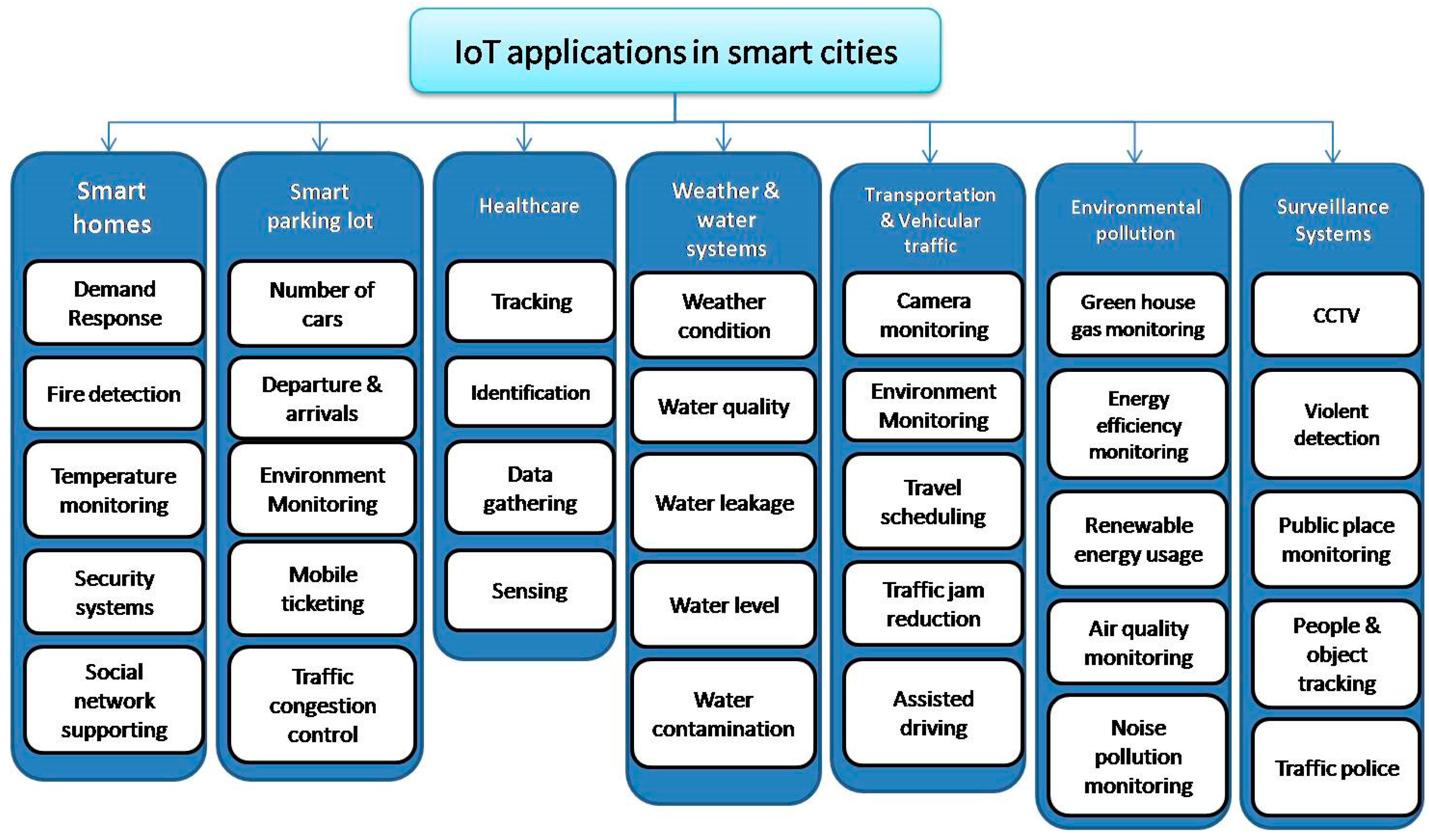
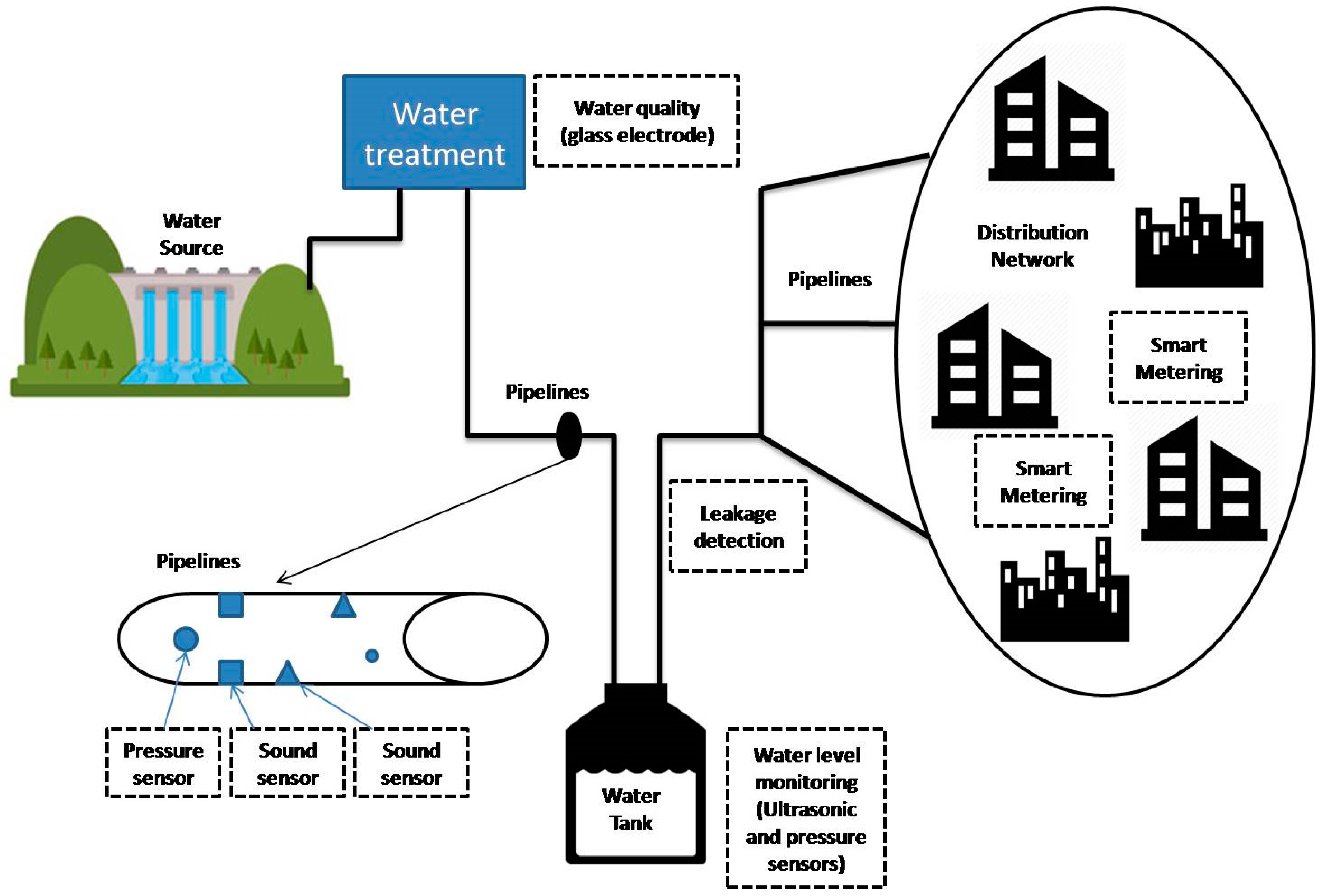
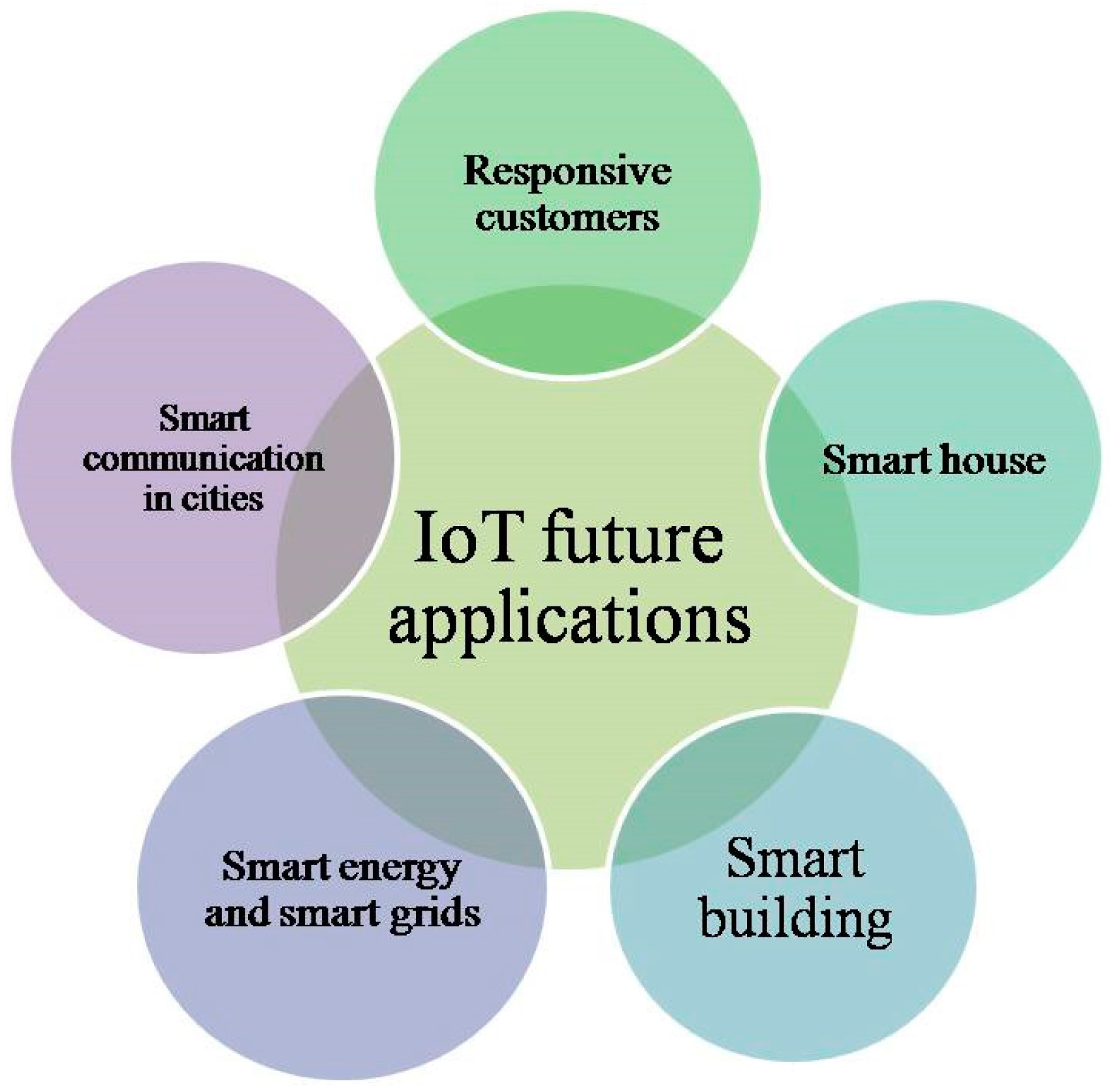
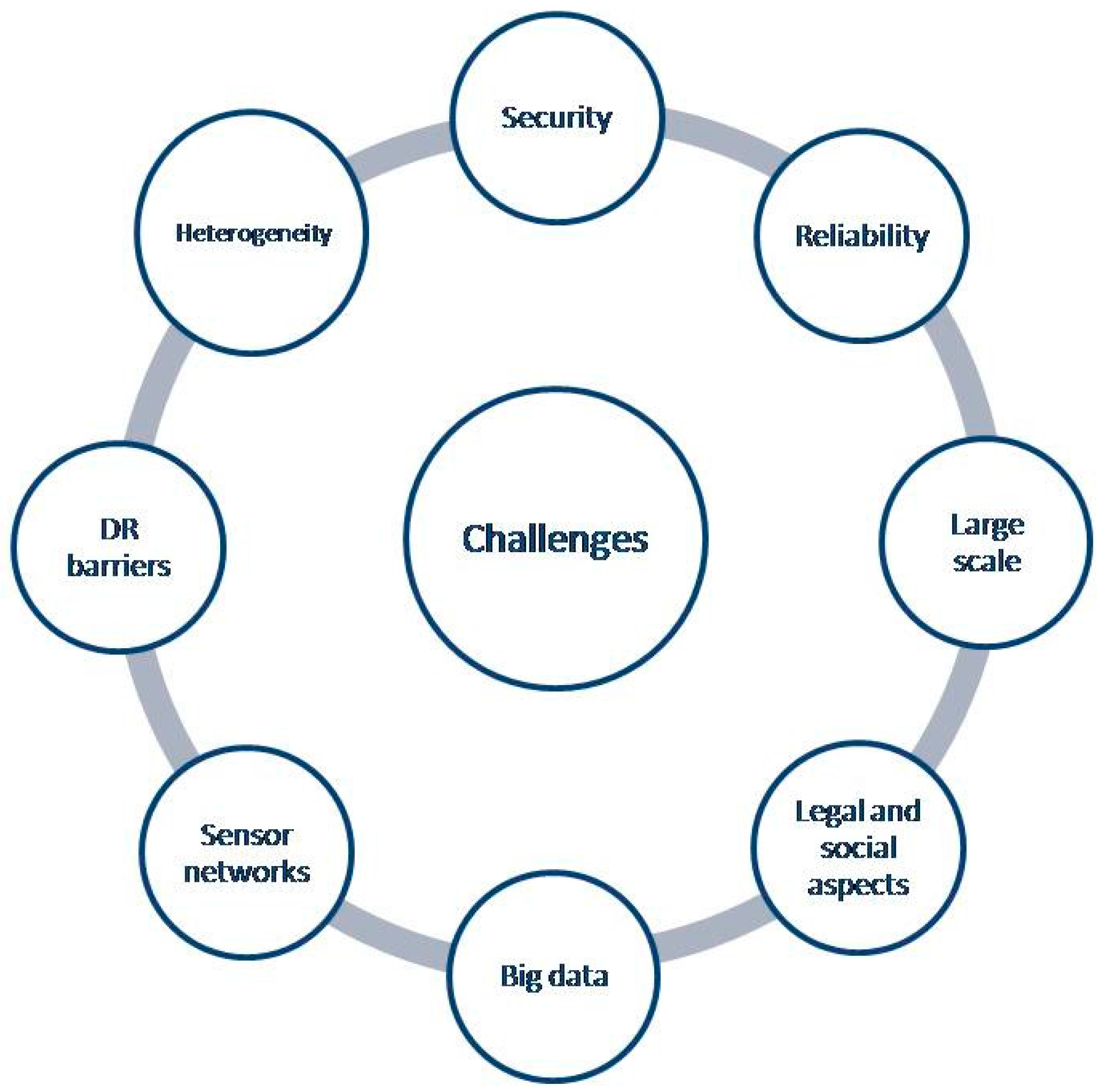
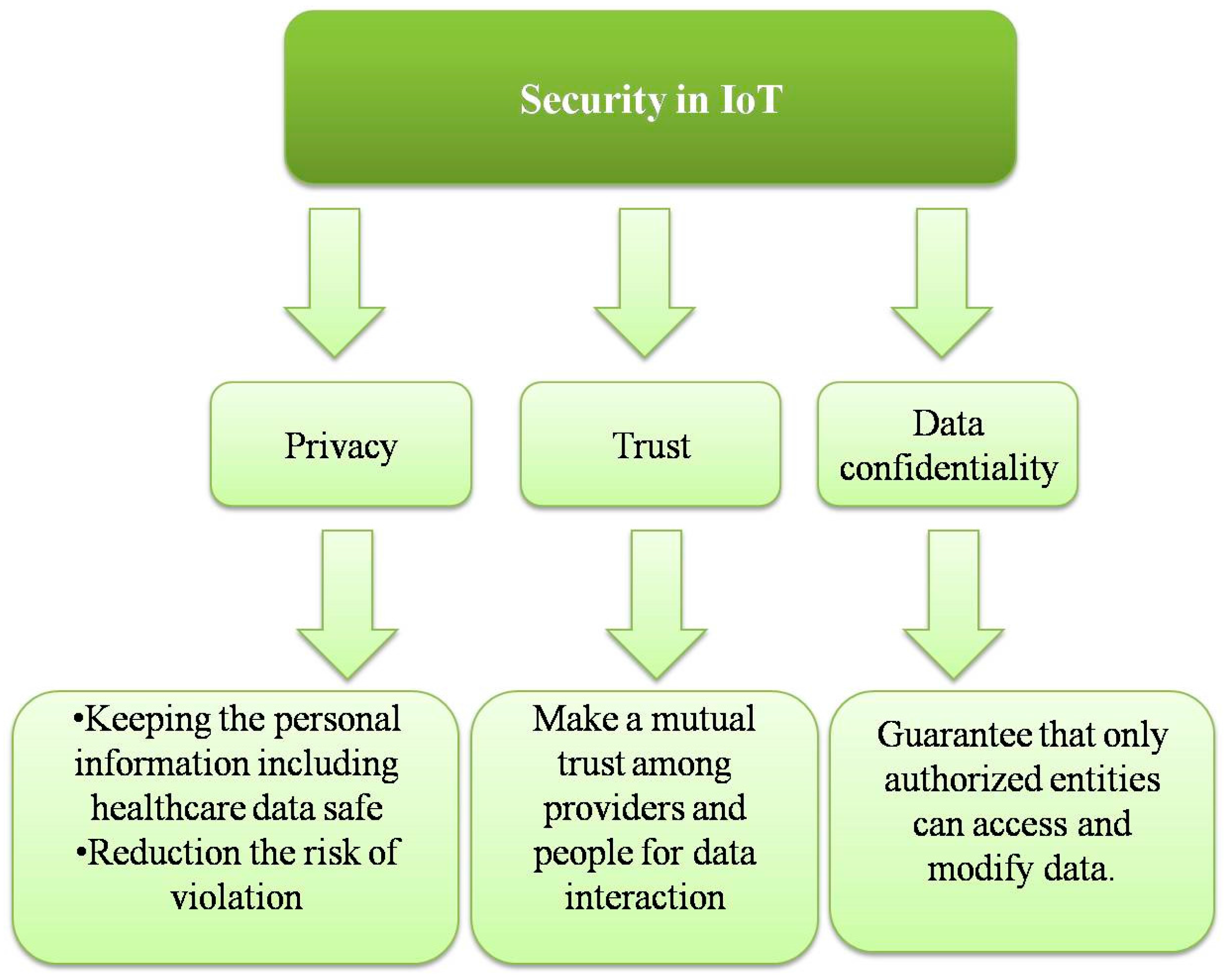
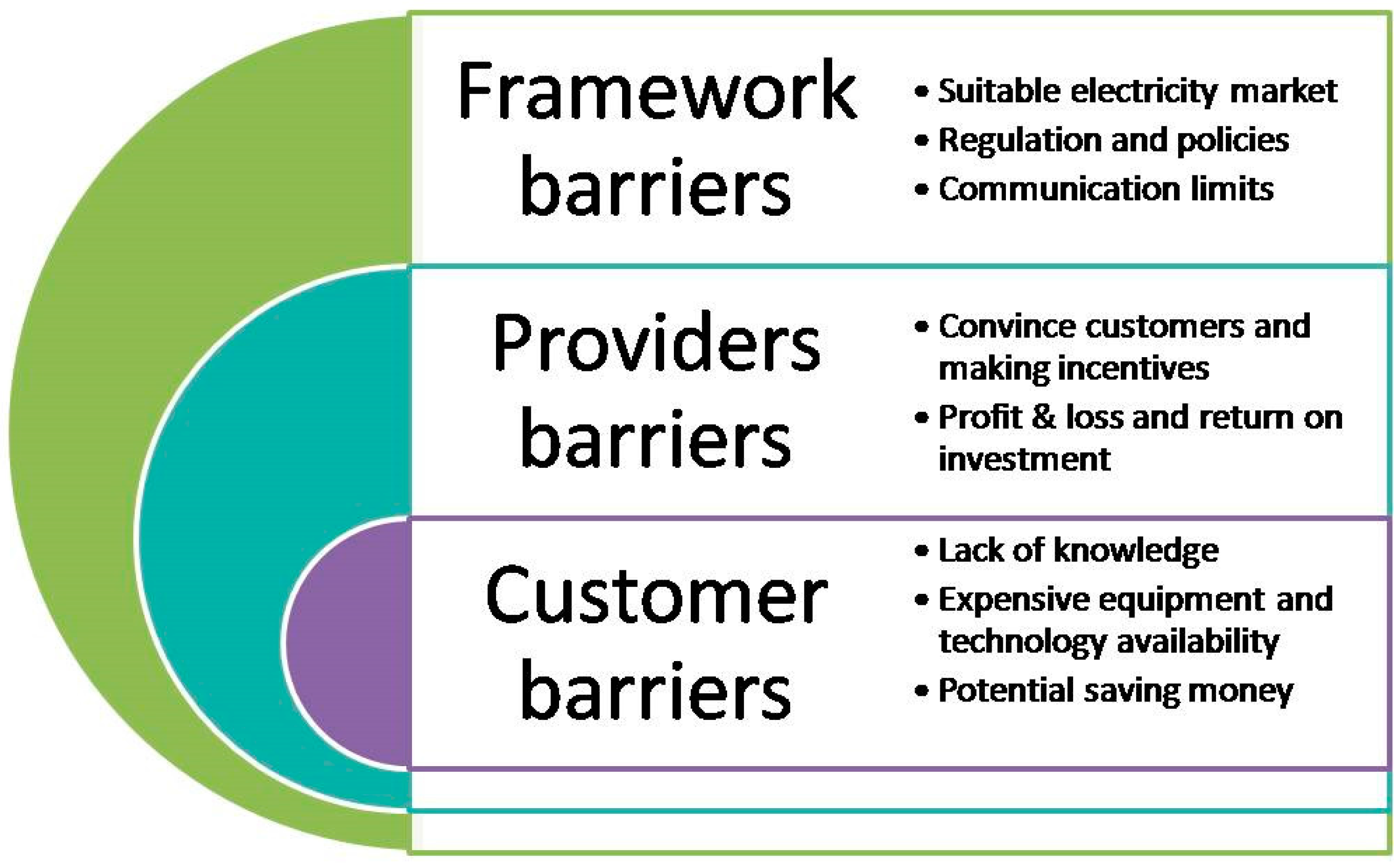
| City | Outcomes |
|---|---|
| Amsterdam [61] | Traffic-reduction, energy conservation, and improvement of the security level |
| Barcelona [62,63,64,65,66] | Accomplishment of sensor technologies, utilizing the information evaluation of traffic flows to design new bus networks as well as the accomplishment of smart traffic |
| Stockholm [67] | Providing global fiber optic networks all over Stockholm |
| Santa Cruz [68] | Analyzing the information of criminal actions to predict the requirements of police and to find the maximum presence of police in the needed regions |
| Songdo, Korea [70] | Fully automated buildings, smart street lighting, smart meters and telepresence |
| PlanIT Valley, Portugal [5] | Deployment of 100,000,000 sensors |
| Fujisawa, Japan [5] | Decrease carbon footprint by 70% |
| Groening, The Netherlands [5] | Improvement of public transportation systems with real-time access to locationss and schedules |
| Norfolk, England [5] | Improvement of data delivery services, data collection and system analysis for the municipality |
| Santander, Spain [5] | Smart parking systems |
| Vienna, Austria [5] | Increasing energy efficiency and climate protection, reduction in carbon footprint |
© 2017 by the authors. Licensee MDPI, Basel, Switzerland. This article is an open access article distributed under the terms and conditions of the Creative Commons Attribution (CC BY) license (http://creativecommons.org/licenses/by/4.0/).
Share and Cite
Talari, S.; Shafie-khah, M.; Siano, P.; Loia, V.; Tommasetti, A.; Catalão, J.P.S. A Review of Smart Cities Based on the Internet of Things Concept. Energies 2017, 10, 421. https://doi.org/10.3390/en10040421
Talari S, Shafie-khah M, Siano P, Loia V, Tommasetti A, Catalão JPS. A Review of Smart Cities Based on the Internet of Things Concept. Energies. 2017; 10(4):421. https://doi.org/10.3390/en10040421
Chicago/Turabian StyleTalari, Saber, Miadreza Shafie-khah, Pierluigi Siano, Vincenzo Loia, Aurelio Tommasetti, and João P. S. Catalão. 2017. "A Review of Smart Cities Based on the Internet of Things Concept" Energies 10, no. 4: 421. https://doi.org/10.3390/en10040421






